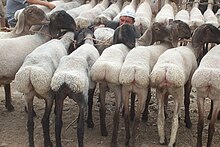Fat-tailed sheep

The fat-tailed sheep is a general type of
Varieties and distribution


Two general varieties of fat-tails exist, the broad fat-tails and the long fat-tails. The long-tailed varieties have the smallest geographical distribution, being found mostly in Arabia (a variety called the Nejd, black with a white head, named for the
Fat-tailed sheep likely moved into Africa through the Horn of Africa, then into Egypt and North Africa, at least by 2000 BC, when they are depicted in Egyptian art. They were the third type of sheep to be brought into Africa.[3]
The majority of fat-tailed sheep breeds have broad fat-tails, where the fat is accumulated in baggy deposits in the hind parts of a sheep on both sides of its tail and on the first 3–5 vertebrae of the tail.[4] Earlier historians including Herodotus report that their tails sometimes were so long that shepherds built miniature carts for them, and that tails sometimes grew so large that it dragged on the ground and hindered copulation.[2] Fat-tailed sheep are well adapted to life in arid landscapes,[5] the fat providing a food reserve for "combatting harsh desert conditions".[2]
The earliest record of fat-tailed sheep is found in ancient
Mesopotamian records provide a wealth of information about fat-tailed sheep (udu gukkal[9] or udu-gug-gal[10]); they produced the highest-quality wool and were kept in large numbers. The city state of Lagash, around 2000 BCE, had over 66,000 such sheep.[9]
Afghanistan
A report published in 1915 by Henry D. Baker, American consul in Bombay, indicates how important the fat-tailed sheep was for Afghanistan. The animal's wool, he says, was one of the country's most important export products; in 1912-1913 the country exported (through Balochistan) for over $1.5 million in wool. Frequently fat-tailed sheep were interbred with Indian sheep to produce high-quality wool. In addition, because the fat was used in the way of butter or ghee, Afghans were able to produce a surplus of ghee for export to India. The animal's meat was the Afghan population's main meat source, according to Baker.[11]
Uzbekistan
Uzbek cuisine is high in fat, and tail fat, called qurdiuq or dumba (often from the Karakul breed), is an important supplier of that fat, which is "revere[d] as a semi-sacred object of gastronomical desire", and used in a variety of national dishes, such as laghman and palov. Food scholar Russell Zanca notes that dumba has become scarce in the post-Soviet era. Under Soviet rule Uzbekistan became a huge grower of cotton, and consequently cottonseed oil took over as the major fat used in cooking; still, dumba continues to play an important role in the Uzbek imagination and folklore.[12]
Tail fat

The tail fat is an essential part of many cuisines.[13]
It is called لية (leeyeh, leyyah, or layeh) in Arabic, zaaka in Algeria, kuyruk yağı in Turkish, and دنبه (donbe or dombe or dumba) in Iran and Pakistan. It emits a strong smell when cooked, though the flavor is described as rich and full.[2]
Breeds
- Adal sheep
- Afghan Arabi
- Afrikaner
- Alai sheep
- Altay sheep
- Arabi sheep
- Armenian Semicoarsewool
- Awassi
- Balkhi
- Blackhead Persian
- Chios
- Damara
- Edilbay
- Karakul
- Laticauda
- Meatmaster
- Mongolian breeds: Khalkh, Baidrag etc.[14][15]
- Pedi
- Red Maasai
- Saryja
- Somali
- Tunis
- Tunisian Barbarin
- Waziri
- Van Rooy sheep
- Zulu, or Nguni (may be fat-tailed or not)
References
- ^
ISBN 978-0-19-211579-9.
- ^ ISBN 090732536X.
- ISBN 9781134679423.
- ^ . Brockhaus and Efron Encyclopedic Dictionary (in Russian). 1906.
- ISBN 9781789254327.
- ISBN 9781782976318.
- ISBN 9781782976318.
- ISBN 9781782976318.
- ^ ISBN 9780485930016.
- ISBN 9781782976318.
- ^ Baker, Henry D. (1915). "Afghanistan". Special Consular Reports. Special Consular Reports, United States. Bureau of Foreign and Domestic Commerce. Vol. 72. U.S. Government Printing Office. pp. 533–60.
- ISBN 0953505715.
- ISBN 9780313327735.
- ^ "Sheep breeds of Mongolia". www.fao.org.
- ^ "Mongolian Sheep". mofa.gov.mn. Archived from the original on 2016-09-16.
External links
 Media related to Fat-tailed sheep at Wikimedia Commons
Media related to Fat-tailed sheep at Wikimedia Commons
